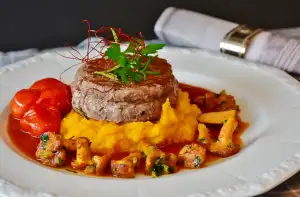Delicious Brazilian Food Recipes to Transport Your Taste Buds to Rio

- Feijoada: Brazil's National Dish
- Coxinha: Popular Brazilian Street Food
- Moqueca: Traditional Brazilian Seafood Stew
- Brigadeiro: Iconic Brazilian Chocolate Truffle
- Pão de Queijo: Cheesy Brazilian Bread Rolls
- Caipirinha: Classic Brazilian Cocktail
- Acarajé: Flavorful Afro-Brazilian Fritters
- Bobó de Camarão: Creamy Shrimp and Cassava Stew
Brazilian cuisine is a vibrant tapestry of flavors influenced by indigenous, African, Portuguese, and immigrant cultures. Known for its diverse ingredients and bold spices, Brazilian food reflects the country's rich culinary heritage. From hearty stews to delectable street snacks, each dish tells a story of Brazil's cultural fusion. The use of tropical fruits, fresh seafood, and exotic meats like feijoada (black bean stew with pork) showcases the country's bountiful natural resources. Whether savoring traditional dishes or indulging in modern interpretations, exploring Brazilian cuisine is a journey through history and flavor.
Feijoada: Brazil's National Dish
Feijoada, often hailed as Brazil's national dish, is a hearty stew that reflects the country's diverse culinary influences. This flavorful dish typically consists of black beans cooked with a variety of pork cuts like sausage, bacon, and ribs. Feijoada is traditionally served with rice, collard greens, orange slices, and farofa (toasted cassava flour). It originated from the Portuguese bean stew but evolved in Brazil to incorporate local ingredients and cooking techniques. Enjoyed during special occasions and gatherings, feijoada embodies the rich history and flavors of Brazilian cuisine.
Coxinha: Popular Brazilian Street Food
Coxinha, a beloved Brazilian street food, is a savory snack that has captured the hearts of locals and visitors alike. Shaped like a teardrop, this deep-fried delight features a creamy filling of shredded chicken wrapped in dough, coated in breadcrumbs, and fried to golden perfection. Legend has it that Coxinha's shape resembles a chicken thigh, hence its name ("little chicken thigh" in Portuguese). Whether enjoyed as a quick bite on the go or as part of a leisurely meal, Coxinha offers a burst of flavor that embodies the essence of Brazilian culinary culture.
Moqueca: Traditional Brazilian Seafood Stew
Moqueca is a traditional Brazilian seafood stew originating from the states of Bahia and Espirito Santo. This flavorful dish typically features fish, shrimp, or both, cooked in a fragrant coconut milk and palm oil broth with tomatoes, onions, garlic, coriander, and bell peppers. The stew is slowly simmered to allow the flavors to meld together beautifully. Moqueca is often served with rice and farofa (toasted cassava flour) on the side, making it a comforting and satisfying meal that showcases the rich culinary heritage of Brazil.
Brigadeiro: Iconic Brazilian Chocolate Truffle
**Brigadeiro: Iconic Brazilian Chocolate Truffle**
One cannot explore Brazilian cuisine without indulging in Brigadeiro, the beloved chocolate truffle that holds a special place in the hearts of Brazilians. This iconic sweet treat is a staple at birthday parties, weddings, and other celebrations across the country. Made from condensed milk, cocoa powder, butter, and chocolate sprinkles for coating, Brigadeiros are rolled into bite-sized balls and enjoyed as a decadent dessert. The name "Brigadeiro" actually pays homage to Brigadier Eduardo Gomes, a prominent figure in Brazilian history. These rich and fudgy truffles are a must-try for anyone looking to experience the true essence of Brazilian culinary delights.
Pão de Queijo: Cheesy Brazilian Bread Rolls
Pão de Queijo, or Brazilian cheese bread rolls, are a beloved staple in Brazilian cuisine. These delightful treats originated in the state of Minas Gerais and have become popular throughout the country. Made with tapioca flour and cheese, pão de queijo has a unique chewy texture and a cheesy flavor that is hard to resist. These gluten-free delights are often enjoyed as a snack or for breakfast, paired perfectly with a cup of coffee or as an accompaniment to soups and stews. The combination of crispy exterior and soft, cheesy interior makes pão de queijo a favorite among locals and visitors alike.
Caipirinha: Classic Brazilian Cocktail
Caipirinha, a classic Brazilian cocktail, is a beloved drink that captures the spirit of Brazil. Made with cachaça (a distilled spirit made from sugarcane), lime, sugar, and ice, this refreshing beverage is a staple at parties and gatherings across the country. The origins of the caipirinha date back to the early 20th century in rural areas of Brazil where it was initially used as a remedy for colds. Today, it is enjoyed by locals and tourists alike for its zesty and invigorating flavors. So next time you want to savor a taste of Brazil, whip up a caipirinha and transport yourself to the vibrant streets of Rio de Janeiro.
Acarajé: Flavorful Afro-Brazilian Fritters
Acarajé is a beloved Afro-Brazilian street food that originated in the northeastern state of Bahia. These flavorful fritters are made from black-eyed peas, onions, and salt, then deep-fried in dendê (palm oil) until crispy on the outside and soft on the inside. Traditionally served split in half and filled with vatapá (a creamy paste made from shrimp, coconut milk, and peanuts) and caruru (okra stew), acarajé offers a unique blend of textures and flavors that reflect Brazil's diverse culinary heritage. The dish is often sold by Baianas, women dressed in traditional white attire who skillfully prepare acarajé on the streets of Salvador, adding to its cultural significance.
Bobó de Camarão: Creamy Shrimp and Cassava Stew
Bobó de Camarão is a rich and creamy shrimp stew that originates from the northeastern region of Brazil. This dish combines fresh shrimp with cassava, coconut milk, tomatoes, onions, garlic, and coriander to create a flavorful and comforting meal. The cassava, also known as yuca or manioc, adds a unique texture to the stew while the coconut milk provides a hint of sweetness. Bobó de Camarão is traditionally served over white rice or alongside farofa, a toasted cassava flour mixture. This dish showcases the diverse flavors and influences found in Brazilian cuisine, making it a must-try for anyone looking to experience the authentic tastes of Brazil.
Brazilian cuisine is a vibrant tapestry of flavors, influenced by diverse cultural backgrounds and rich culinary traditions. From the hearty Feijoada to the indulgent Brigadeiro, each dish tells a story of Brazil's history and heritage. By exploring recipes like Coxinha, Moqueca, Pão de Queijo, Caipirinha, Acarajé, and Bobó de Camarão, you can embark on a culinary journey that will transport your taste buds to the lively streets of Rio de Janeiro. So why not bring a taste of Brazil into your own kitchen? Gather your ingredients, follow the recipes with care, and savor the delicious flavors that this South American gem has to offer. Bom apetite!
Published: 30. 03. 2024
Category: Recipes



